In May I went to a large international conference, EcoMotion 2020, devoted to the exciting innovative field of autonomous vehicles and other novel means of transport. There were 3,000 attendees from 54 countries and 211 exhibitors.
It was a magnificent event.
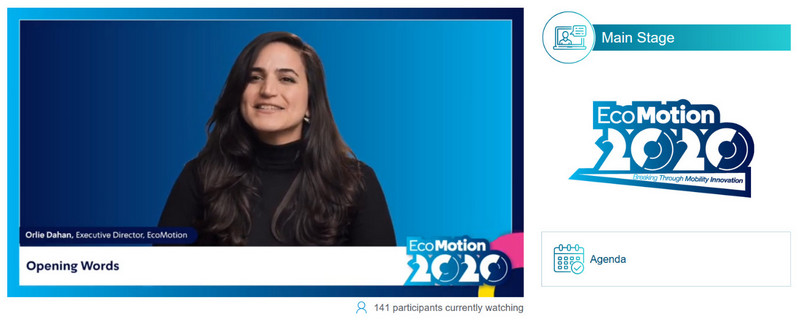
Welcome speech at the start of the event
Of course, in May I couldn’t possibly have gone to a large conference… not with the blasted Coronavirus imposing social distancing and travel bans. In May I stayed at home. And yet I went to EcoMotion 2020, and it most definitely was a magnificent event.
The impact of COVID-19 on the event industry has been dire; I myself missed a trip to give an invited lecture on Information Overload in an event in Denver, which had been hastily cancelled. But in the same month I went to EcoMotion 2020, because rather than cancel it, the organizers had converted it to a virtual conference. And what made it a magnificent was the way they did it, which was so amazing that I went and talked to the organizers to learn how they managed to pull it off. I was pleasantly surprised by their methodology. Read on and learn!
EcoMotion is a non-profit joint venture of the Israel Innovation Institute, the Smart Mobility Initiative (Prime Minister’s Office), the Ministry of Economy, and the Israeli Automotive & High-tech industries. A dynamic and growing community in the Smart Mobility Sector, it is comprised of over 600 startups and 11,000 community members.
Now, I had my tickets all paid and ready in Eventbrite for a conference on May 19. You know this kind of event: a posh venue, parallel sessions and a plenary hall, a vendor exhibition, sponsors, mingling breaks, and an endless flow of coffee and pastries. Oh, and great food for lunch.
And then on April 26 – just 3 weeks before the event – I received an email giving me the option to either (a) cancel and get a refund, or (b) get a partial refund and attend the virtual event. I chose option (b), expecting some kind of Zoom session with ill-lighted speakers seated at their kitchen tables or basement home offices. The event had a full day’s agenda, but I doubted it could hold my attention for more than an hour or two.
I couldn’t have been more wrong.
The conference had all the elements of a face to face event, except for the food. There were:
- A main stage, where the major talks were given (after the usual greetings, of course).
- Happy hour sessions – BYOB, inevitably, but with the correct easygoing spirit.
- Fireside chats and moderated Panel discussions.
- A sponsors exhibition.
- A startup showcase with scores of startup booths.
However, this wasn’t a kitchen and basement Zoom thing; It was all managed on a platform that applied numerous cool tricks to give a better experience, including:
- The main stage web page had a list of all the talks and panels, each with a “Watch” link. Each link only became active at the hour stated on the agenda – but once active, you could watch it from the start of the talk (if you came in late), and you could go back and forth (Rewind and Fast Forward). You could also watch already-completed talks later in the day (but not ones scheduled for a future time). This is actually better than live!
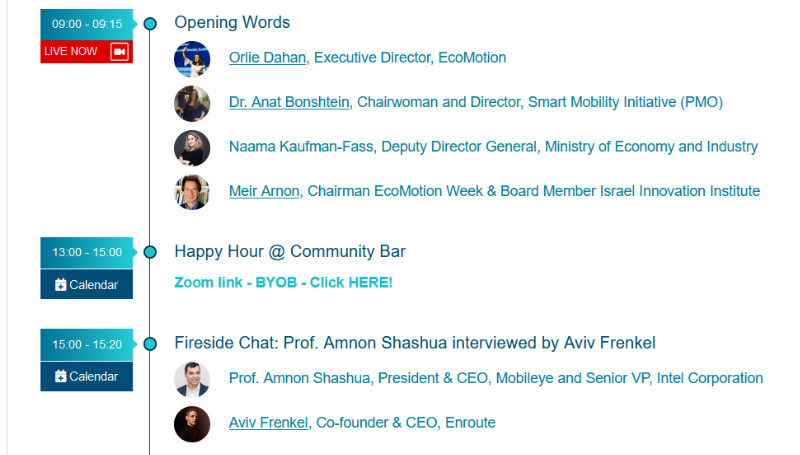
Part of the main agenda. Note the “Live Now” icon.
- Speaking of the talks, interviews and panels – these looked sleekly professional, almost as good as prime time television programming, even though the panelists and moderators might be isolated in their individual homes.
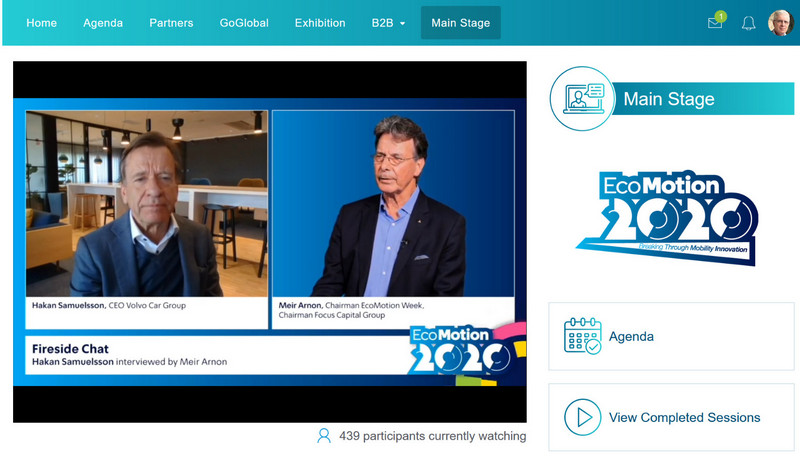
An interviewer in Israel talking to Volvo’s CEO overseas on the Main Stage page
- The startups showcase had 170 exhibiting startups, in a nifty UI that allowed you to browse them or to search for your interests.
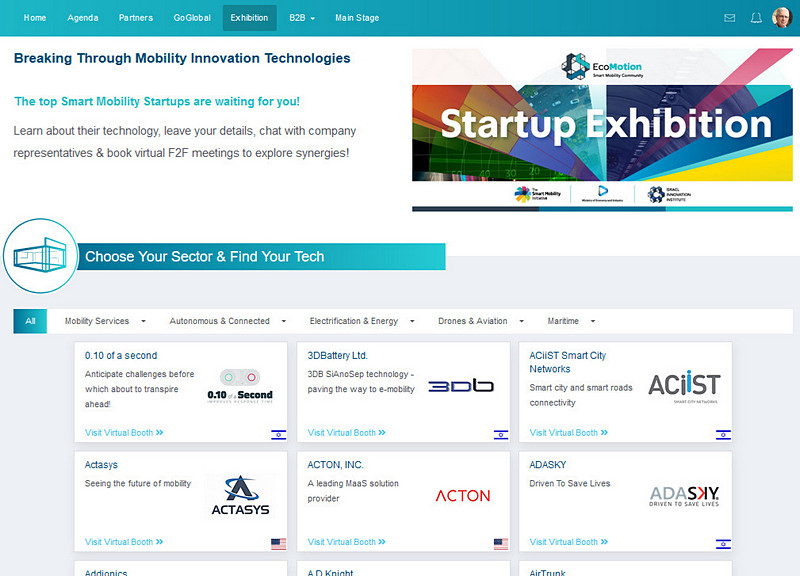
The startups showcase page
- For each startup you could learn about it and its founders, and you could “leave your business card” – notify the startup that you wanted to talk to them, in which case a Zoom meeting could be set up within the platform itself for later that day. Startups could also search the attendee directory and ask to meet people of interest to them.
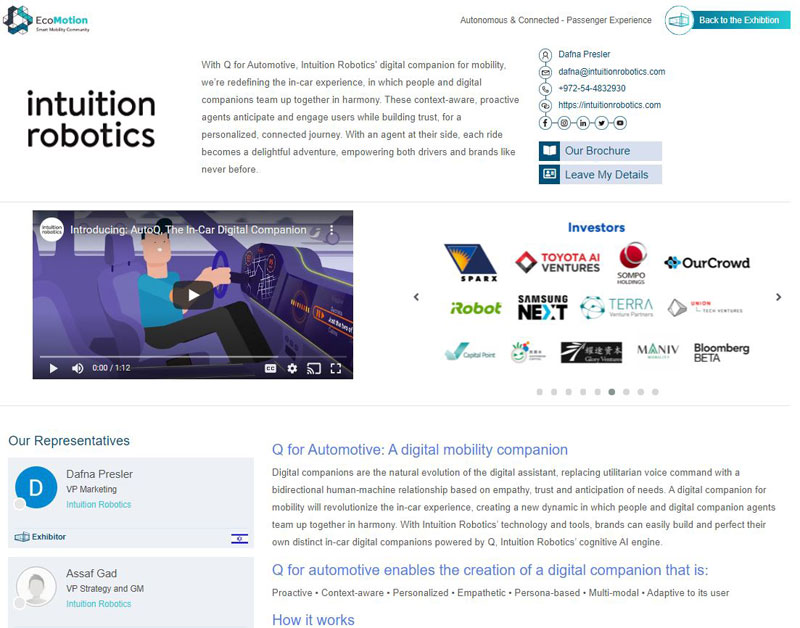
A startup “virtual booth”
- The Happy Hour did use Zoom, but with the breakout rooms feature put to good use, so after some preliminaries attendees were moved intro small groups where they could mingle and interact.
Bottom line: just as good as the planned real life event (minus the food… sigh).
This was an order of magnitude better than any virtual conference I’ve ever seen. I was impressed. But given my background in management and behavior, I was just as impressed that they’d pulled this feat off in less than a month. How was that even possible? Well, that was easy to resolve: I went and asked!
I contacted the EcoMotion team and had a long talk with one of the organizers. This is what I learned:
When it became clear that COVID-19 regulations will preclude holding the planned physical event, they made a decision: the event must happen, no matter what, whatever it takes. Giving up was not an option. There is something quintessentially Israeli about this approach, in the spirit of the phrase we have here: “This is what there is – and with this we shall win”. Wayda go, EcoMotion team!
So they started to look for a virtual platform, and found that there is an Israeli company, FormsWizard, that had been making event registration software, but was now working on a complete event platform. This wasn’t even ready at the time, but might be finished just in time for EcoMotion 2020. And the team made a risk decision: they would work with FormsWizard to finish and use the platform for the event that was mere weeks ahead; and they would commit to the date – sell the revised tickets – even before the tool was ready. A big risk, and a courageous decision.
Meanwhile, they found a video production company, CUTAWAY Studio, that agreed to help make the talks and panels a success. They did this by taking remote control of the speakers’ and moderators’ computers (yes, the ones in their kitchens and basements), so they could guide them to make the recordings correctly and enable the needed post-processing. This way they could have good quality videos made in people’s remote homes. You can see some of the resulting sessions online here.
And they made lemonade from the lemon handed them by the pandemic – given the remote attendance, they could now have talks by senior managers from overseas who might not have been willing to travel to a physical event. In the end all the risks worked out to the best, and we had a lovely conference.
All this was music to my ears because it is exactly what I advocated regarding the COVID-induced Work-from-Home move: that we should not just send people home, but should grab the opportunity to devise improved methodologies that will make the telecommuting mode better than ever. And of course I just loved the Chutzpah of committing to a completely untested technology and making it work!
So – I learned much about all kinds of futuristic vehicles, but a takeaway I cherish is a comment by Prof. Amnon Shashua, the founder of Mobileye. Asked if he was optimistic in the midst of this pandemic, he replied “Of course. If you’re an entrepreneur, you’re optimistic. You can’t be a pessimistic entrepreneur”.
So – be well, and stay optimistic!

